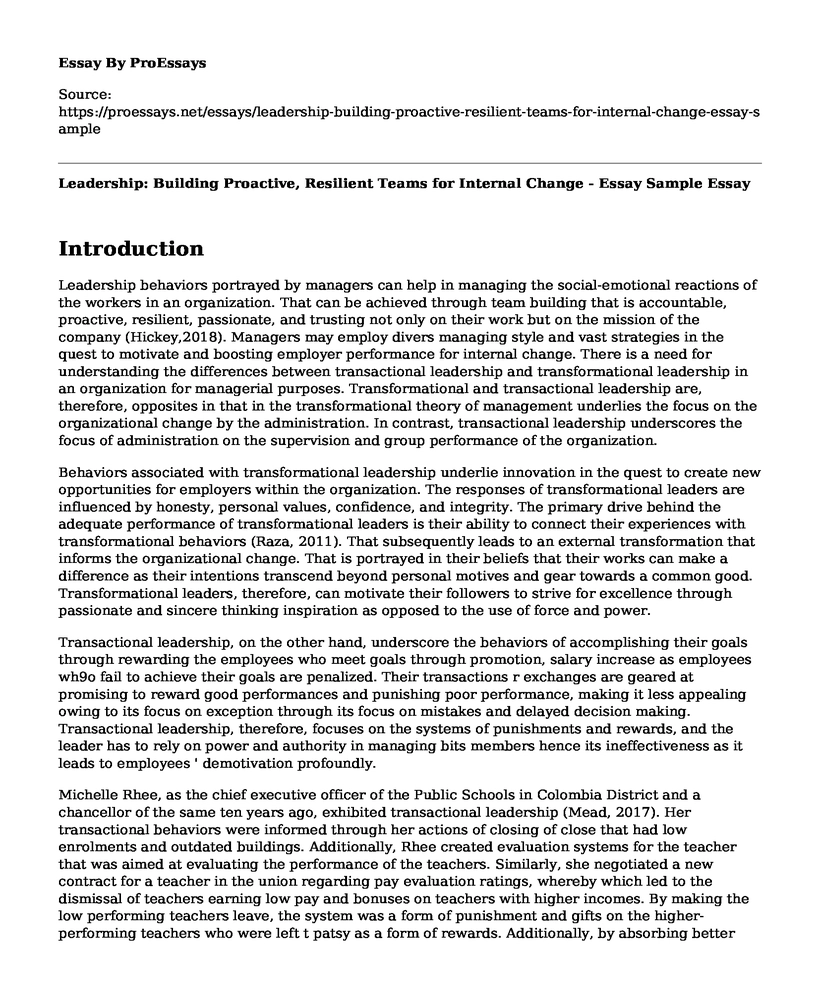Introduction
Leadership behaviors portrayed by managers can help in managing the social-emotional reactions of the workers in an organization. That can be achieved through team building that is accountable, proactive, resilient, passionate, and trusting not only on their work but on the mission of the company (Hickey,2018). Managers may employ divers managing style and vast strategies in the quest to motivate and boosting employer performance for internal change. There is a need for understanding the differences between transactional leadership and transformational leadership in an organization for managerial purposes. Transformational and transactional leadership are, therefore, opposites in that in the transformational theory of management underlies the focus on the organizational change by the administration. In contrast, transactional leadership underscores the focus of administration on the supervision and group performance of the organization.
Behaviors associated with transformational leadership underlie innovation in the quest to create new opportunities for employers within the organization. The responses of transformational leaders are influenced by honesty, personal values, confidence, and integrity. The primary drive behind the adequate performance of transformational leaders is their ability to connect their experiences with transformational behaviors (Raza, 2011). That subsequently leads to an external transformation that informs the organizational change. That is portrayed in their beliefs that their works can make a difference as their intentions transcend beyond personal motives and gear towards a common good. Transformational leaders, therefore, can motivate their followers to strive for excellence through passionate and sincere thinking inspiration as opposed to the use of force and power.
Transactional leadership, on the other hand, underscore the behaviors of accomplishing their goals through rewarding the employees who meet goals through promotion, salary increase as employees wh9o fail to achieve their goals are penalized. Their transactions r exchanges are geared at promising to reward good performances and punishing poor performance, making it less appealing owing to its focus on exception through its focus on mistakes and delayed decision making. Transactional leadership, therefore, focuses on the systems of punishments and rewards, and the leader has to rely on power and authority in managing bits members hence its ineffectiveness as it leads to employees ' demotivation profoundly.
Michelle Rhee, as the chief executive officer of the Public Schools in Colombia District and a chancellor of the same ten years ago, exhibited transactional leadership (Mead, 2017). Her transactional behaviors were informed through her actions of closing of close that had low enrolments and outdated buildings. Additionally, Rhee created evaluation systems for the teacher that was aimed at evaluating the performance of the teachers. Similarly, she negotiated a new contract for a teacher in the union regarding pay evaluation ratings, whereby which led to the dismissal of teachers earning low pay and bonuses on teachers with higher incomes. By making the low performing teachers leave, the system was a form of punishment and gifts on the higher-performing teachers who were left t patsy as a form of rewards. Additionally, by absorbing better performing teachers and giving them the opportunities for improvement was an aspect of transformation on the teachers. That is a clear indication that Rhee's controversial leadership styles were based on the realms of both transformational and transactional leadership.
Finally, leaders may exhibit diverse forms of leadership skills in the organization in the quest to attain organizational goals. Transactional leadership is based on reward systems and punishment, and the use of power and authority on the employers. Transformational leadership, on the other hand, is based on selfless employee motivation through the creation of opportunities that enhances the employees' passionate performances in the organization. Transformational leadership is, by far, the best leadership behavior that every leader should have.
References
Ingram, D (2019, February).Transformational Leadership vs. Transactional Leadership,Definition.Chron. Retrieved from https://smallbusiness.chron.com/transformationalleadership-vs-transactional-leadership-definition-13834.html
Hickey, K (2020).5 key Leadership Behaviors You Must Have. Better Up. Retrieved fromhttps://www.betterup.com/en-us/blog/5-key-leadership-behaviors-you-must-have
Mead, S. (2017, April).The Capital of Education Reform: Put Politics Aside and Learn fromunn the read: articles/exploring ANSCATIONBAL.Retrieved formulas.rom the Successful; Changes and authority on the employers.
Successful Changes Michelle Rhee Brought to Washington DC schools.U.S.News.Retrieved from https://www.usnews.com/opinion/knowledge-bank/articles/2017-0420/michelle-rhee-set-national-example-of-education-reform-in-washington-dc
Raza, T. (2019, November).Exploring Transformational and Transactional Leadership Styles.Queen's University ITC. Retrieved from https://irc.queensu.ca/articles/exploringtransformational-and-transactional-leadership-styles
Cite this page
Leadership: Building Proactive, Resilient Teams for Internal Change - Essay Sample. (2023, Apr 04). Retrieved from https://proessays.net/essays/leadership-building-proactive-resilient-teams-for-internal-change-essay-sample
If you are the original author of this essay and no longer wish to have it published on the ProEssays website, please click below to request its removal:
- Literature Review: Leading Change in Organizations Paper Example
- Research Paper on Operation Project Management: Oman Telecommunications Company
- Essay Sample on Safety Risk Management: Identify, Evaluate, Analyze & Mitigate Risk
- Essay on My Journey to Leadership: A Story of Success
- Transformational Leadership & Job Design Impact on Employee Wellness & Performance - Essay Sample
- Strategic Decision-Making: Crafting Options for Optimum Success - Essay Sample
- Essay Sample on Achieving Global Leadership: Quality Management and Programs







